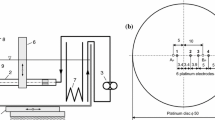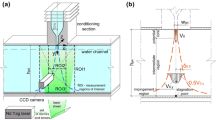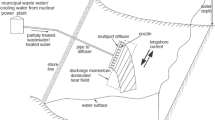Abstract
An experimental study has been performed by using particle image velocimetry to investigate the effect of nozzle-to-plate separation distance (L) and jet impingement angle on the flow characteristics of an obliquely inclined submerged water jet. Measurements were taken for L = 1D, 2D, 4D and 6D (where D is the diameter of the nozzle) for the jet impingement angle (θ) of 45° and 26°, and the flow characteristics in the uphill and the downhill regions are investigated at Reynolds number of 2600 (based on the nozzle diameter D and the jet velocity \(U_{{\text{o}}}\)). It is observed that surface spacing has an opposite effect in the uphill and the downhill regions in terms of wall jet flow. In the uphill region, the tendency of the wall jet to grow increases with increase in L/D. However, in the downhill region, the jet velocity and its thickness are observed to reduce as the separation distance is increased. The distance between the stagnation point and the geometric centre is observed to decrease with increase in L/D because of jet–ambient fluid interaction in the uphill region. The jet width is observed to grow for θ = 45° in the downstream of the plate due to enhanced jet–ambient fluid interaction. Flow at θ = 26° shows that after impingement the entire jet deviates towards the downhill side, which indicates the existence of a critical impingement angle below which there is no flow of the jet in the uphill region. RMS velocity fluctuations and shear stress show an increased turbulence level downstream of the plate in the downhill region for smaller impinging distance implying higher jet–ambient fluid interaction and increased jet width. They, along with the negative turbulence production term, reveal the region of flow separation and reattachment. The decrease in the peak value of Nusselt number can be related to the drop in the jet momentum at the stagnation point with increase in the surface spacing.
Graphic abstract

















Similar content being viewed by others
References
Akansu YE, Sarioglu M, Kuvvet K, Yavuz T (2008) Flow field and heat transfer characteristics in an oblique slot jet impinging on a flat plate. Int Commun Heat Mass Transf 35:873–880
Babic DM, Murray DB, Torrance AA (2005) Mist jet cooling of grinding processes. Int J Mach Tools Manuf 45:1171–1177
Beitelmal AH, Saad MA, Patel C (2000) The effect of inclination on the heat transfer between a flat surface and an impinging two-dimensional air jet. Int J Heat Fluid Flow 21:156–163
Beltaos S, Rajaratnam N (1977) Impingement axisymmetric developing jets. J Hydraul Res 15(4):311–325
Chaudhari M, Puranik B, Agrawal A (2010) Heat transfer characteristics of synthetic jet impingement cooling. Int J Heat Mass Transf 53(5–6):1057–1069
Choo K, Kang TY, Kim SJ (2012) The effect on inclination on impinging jet at small nozzle to plate spacing. Int J Heat Mass Transf 55:3327–3334
Cimarelli A, Leonforte A, De Angelis E, Crivellini A, Angeli D (2019) On negative turbulence production phenomena in the shear layer of separating and reattaching flows. Phys Lett A 383:1019–1026
Coleman HW, Steele WG (2009) Experimentation, validation, and uncertainty analysis for engineers. Wiley, Hoboken
Eskinazi S, Erian F (1969) Energy reversal in turbulent flows. Phys Fluids 12(10):1988–1998
Fillingham P, Novosselov I (2018) Similarity of the wall jet resulting from planar underexpanded impinging jets. arXiv preprint arXiv: 1812.11220
Foss JF (1979) Measurements in a large angle oblique jet impingement flow. AIAA J 14:801–802
Gardon R, Akfirat JC (1965) The role of turbulence in determining the heat-transfer characteristics of impinging jets. Int J Heat Mass Transf 8(10):1261–1272
George WK, Abrahamsson H, Eriksson J, Karlsson RI, Lofdahl L, Wosnik M (2000) A similarity theory for the turbulent plane wall jet without external stream. J Fluid Mech 425:367–411
Glauert MB (1956) The wall jet. J Fluid Mech 1:625–643
Goldstein RJ, Franchett ME (1988) Heat transfer from a flat surface to an oblique impinging jet. J Heat Transf 110:84–90
Gulati P, Katti V, Prabhu SV (2009) Influence of the shape of the nozzle on local heat transfer distribution between smooth flat surface and impinging air jet. Int J Heat Mass Transf 29:1227–1235
Hammond GP (1982) Complete velocity profile and ‘optimum’ skin friction formulas for the plane wall jet. J Fluids Eng 104:59–65
Hashiehbaf A, Baramade A, Agrawal A, Romano GP (2015) Experimental investigation on an axisymmetric turbulent jet impinging on a concave surface. Int J Heat Fluid Flow 53:167–182
Hollworth BR, Durbin M (1992) Impingement cooling of electronics. J Heat Transf 114:607–613
Jalil A, Rajaratnam N (2006) Oblique impingement of circular water jets on a plane boundary. J Hydraul Res 44:807–814
Knowles K, Myszko M (1998) Turbulence measurements in radial wall-jets. Exp Therm Fluid Sci 17:71–78
Lazar E, DeBlauw B, Glumac N, Dutton C, Elliott G (2010) A practical approach to PIV uncertainty analysis. In: Proceedings of the 27th AIAA aerodynamic measurement technology and ground testing conference, AIAA paper no. 2010-4355
Lytle D, Webb B (1994) Air jet impingement heat transfer at low nozzle-plate spacings. Int J Heat Mass Transf 37:1687–1697
Myers GE, Schauer JJ, Eustis RH (1963) Plane turbulent wall jet flow development and friction factor. J Basic Eng 85:47–54
Naib SKA, Sanders J (1997) Oblique and vertical jet dispersion in channels. J Hydraul Eng 123(5):456–462
O’Donovan TS, Murray DB (2007) Jet impingement heat transfer—part I: mean and root mean square heat transfer and velocity distributions. Int J Heat Mass Transf 17:3291–3301
O’Donovan TS, Murray DB (2008) Fluctuating fluid flow and heat transfer of an obliquely impinging air jet. Int J Heat Mass Transf 51:6169–6179
Raffel M, Willert C, Kompenhans J (1998) Particle image velocimetry: a practical guide. Springer, Berlin
Sparrow EM, Lovell BJ (1980) Heat transfer characteristics of an obliquely impinging circular jet. J Heat Transf 102:202–209
Stevens J, Webb BW (1991) The effect of inclination on local heat transfer under an axisymmetric, free liquid jet. Int J Heat Mass Transf 34(4-5):1227–1236
Wang L, Hejcik J, Sunden B (2007) PIV measurement of separated flow in a square channel with streamwise periodic ribs on one wall. J Fluids Eng 129:834–841
Wang C, Wang X, Shi W, Lu W, Tan SK, Zhou L (2017) Experimental investigation on impingement of a submerged circular water jet at varying impinging angles and Reynolds numbers. Exp Therm Fluid Sci 89:189–198
Yadav H, Agrawal A (2018a) Effect of vortical structures on velocity and turbulent fields in the near region of an impinging turbulent jet. Phys Fluids 30:035107
Yadav H, Agrawal A (2018b) Self-similar behavior of turbulent impinging jet based upon outer scaling and dynamics of secondary peak in heat transfer. Int J Heat Fluid Flow 72:123–142
Yadav H, Agrawal A, Srivastava A (2016) Mixing and entrainment characteristics of a pulse jet. Int J Heat Fluid Flow 61:749–761
Author information
Authors and Affiliations
Corresponding author
Additional information
Publisher’s Note
Springer Nature remains neutral with regard to jurisdictional claims in published maps and institutional affiliations.
Rights and permissions
About this article
Cite this article
Mishra, A., Yadav, H., Djenidi, L. et al. Experimental study of flow characteristics of an oblique impinging jet. Exp Fluids 61, 90 (2020). https://doi.org/10.1007/s00348-020-2923-y
Received:
Revised:
Accepted:
Published:
DOI: https://doi.org/10.1007/s00348-020-2923-y




